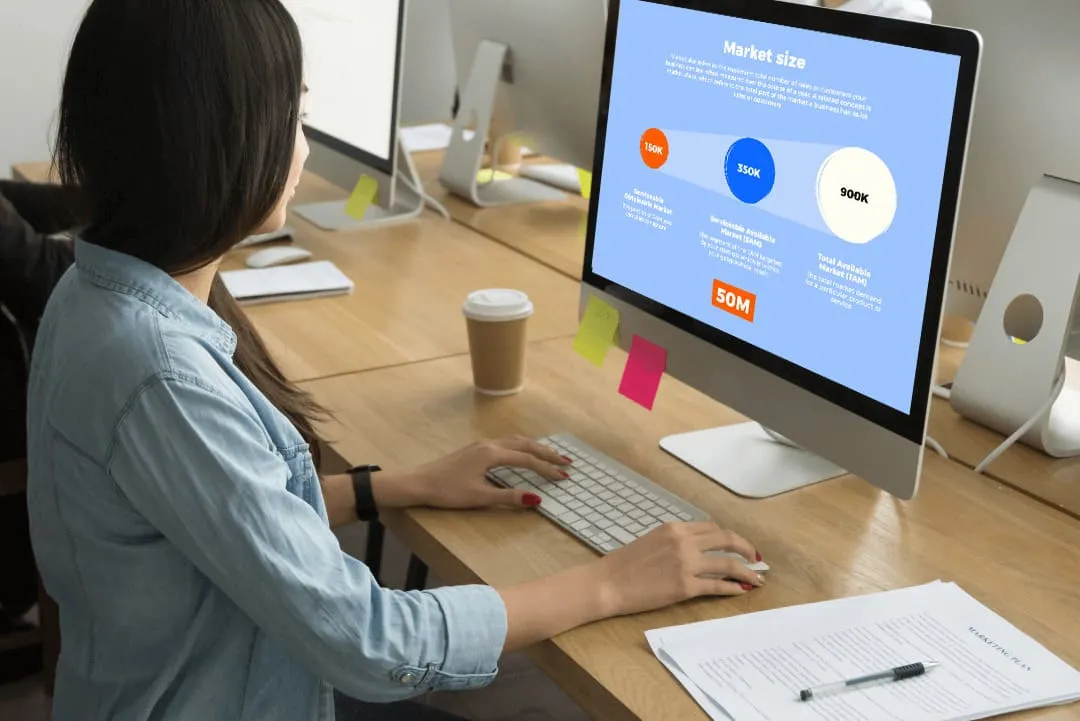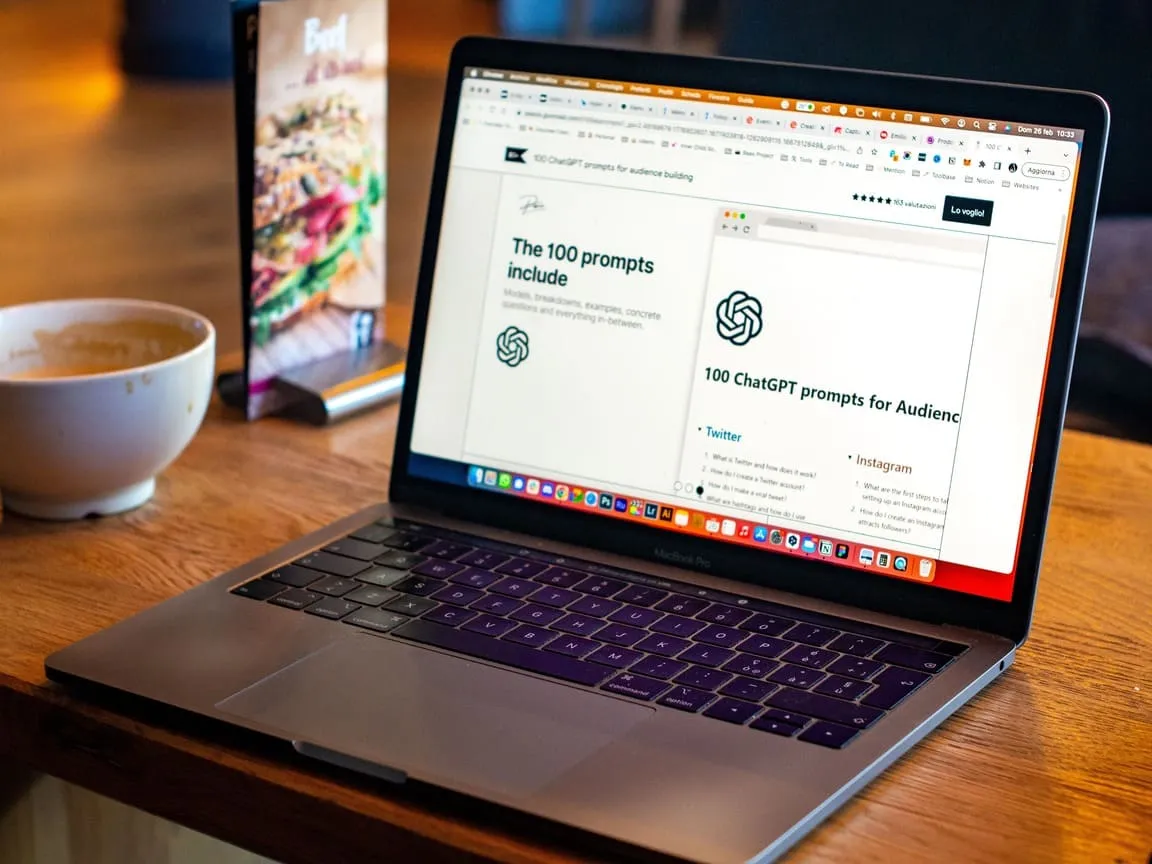
Formal vs. Informal Presentations: Choosing Your Presentation Style
.webp)
Did it occur to you that your career could depend on a presentation you give? Well, according to Forbes, 70% of professionals strongly believe that your future success hangs on your presentation skills. Since the art of presentation is insanely intricate and, at times, overly complicated, the stats are pretty disheartening.
The topic of today’s discussion will be the presentation style. In case you don’t know, there are two primary presentation types: formal and informal. Each has its own rules and peculiarities. What is most important is that you can’t substitute one with the other. The circumstances could be dire.
Formal presentations are usually more traditional, while informal ones open up fresh horizons for creativity and experimentation. Like all professional presentation design services, Whitepage’s team knows the tricks and nuances of either style, and we will share some of our knowledge with you in this guide. Many secrets will open up to you after reading this article, so enough of postponing the inevitable!
Understanding Formal Presentations
A formal presentation is structured, well-planned, professionally delivered, and spiced with a formal language format. It features a formal tone of voice and projects an authoritative vibe. Usually, formal presentations are reserved for professional settings such as academic conferences, business board meetings, sales presentations, etc.
If you are wondering how to do a presentation outline for a formal presentation, you should base the outline on three central pillars:
- A well-defined presentation structure with a clear intro, informative main body, and persuasive conclusion.
- Formal language enhances the credibility and trustworthiness of the presented idea. No room for slang and jargon.
- Strict time limit.
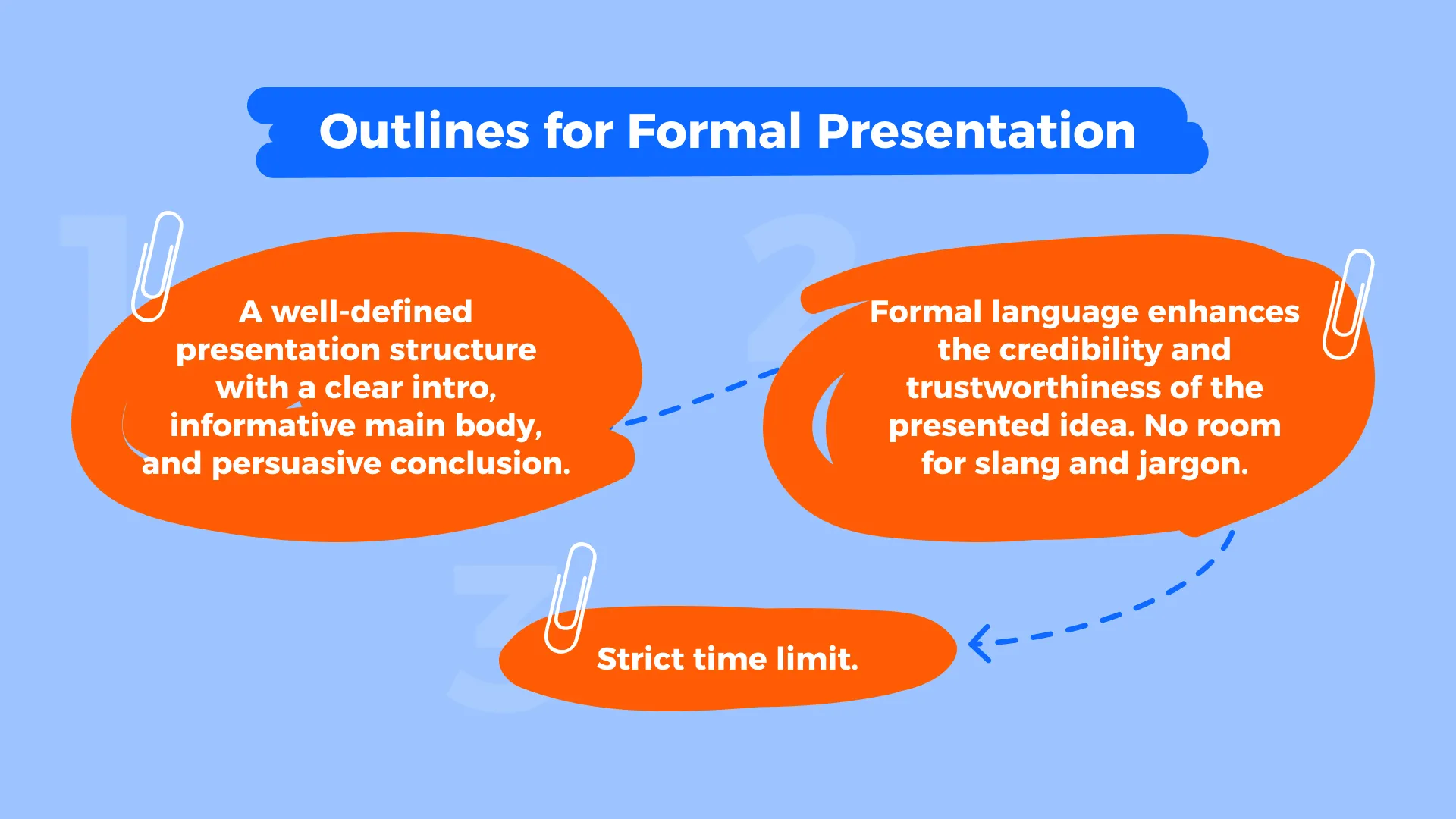
Based on formal presentation topics, we can highlight a few different types of formal presentations:
- Informative. It is one of the most widely used types. You can use it in corporate, educational, or business settings. The main aim of the format is to introduce vital information on the subject in front of a professional audience.
- Persuasive. This formal presentation format is used to convince or motivate the audience to achieve a pre-set goal.
- Demonstrative. Presentation of a new product or concept that will revolutionize the industry.
- Inspirational. A type of presentation charged to make an emotional connection between the audience and the presented idea.

When should you choose a formal presentation?
- When you are presenting in front of a decision-making audience – investors, stakeholders, senior executives, or board members.
- When you are introducing a complicated idea spiced with statistical data and other industry-specific information.
- When you are presenting in a traditional setting, and you are not fully aware of the cultural intricacies of the audience.
Exploring Informal Presentations
An informal presentation, or an impromptu presentation, is a more creative, spontaneous, relaxed, and conversational interaction with the audience. Usually, the informal presentation definition centers around casual delivery, spiced with personal anecdotes, collaborative tilt, emotions and humor.
To better understand the core of an informal presentation, we will draw a few parallels with a formal one. The main characteristics of formal presentation are undiluted professionalism, logical structure, and solid protocols. At the same time, an informal format relies on flexibility, adaptability, and creativity. A formal presentation is often referred to when you need to present something fundamental and complicated, and an informal formal implies dialogue, discussion, and interaction.
Any pitch deck design service would recommend an informal presentation as your best bet when you are planning a team meeting, a brainstorming session, or an informal training gathering. Due to the flexible structure, conversational tone, and direct collaboration with the audience, informal presentations will help you gain the most when placed into any of the described scenarios.
Tips for selecting an informal approach
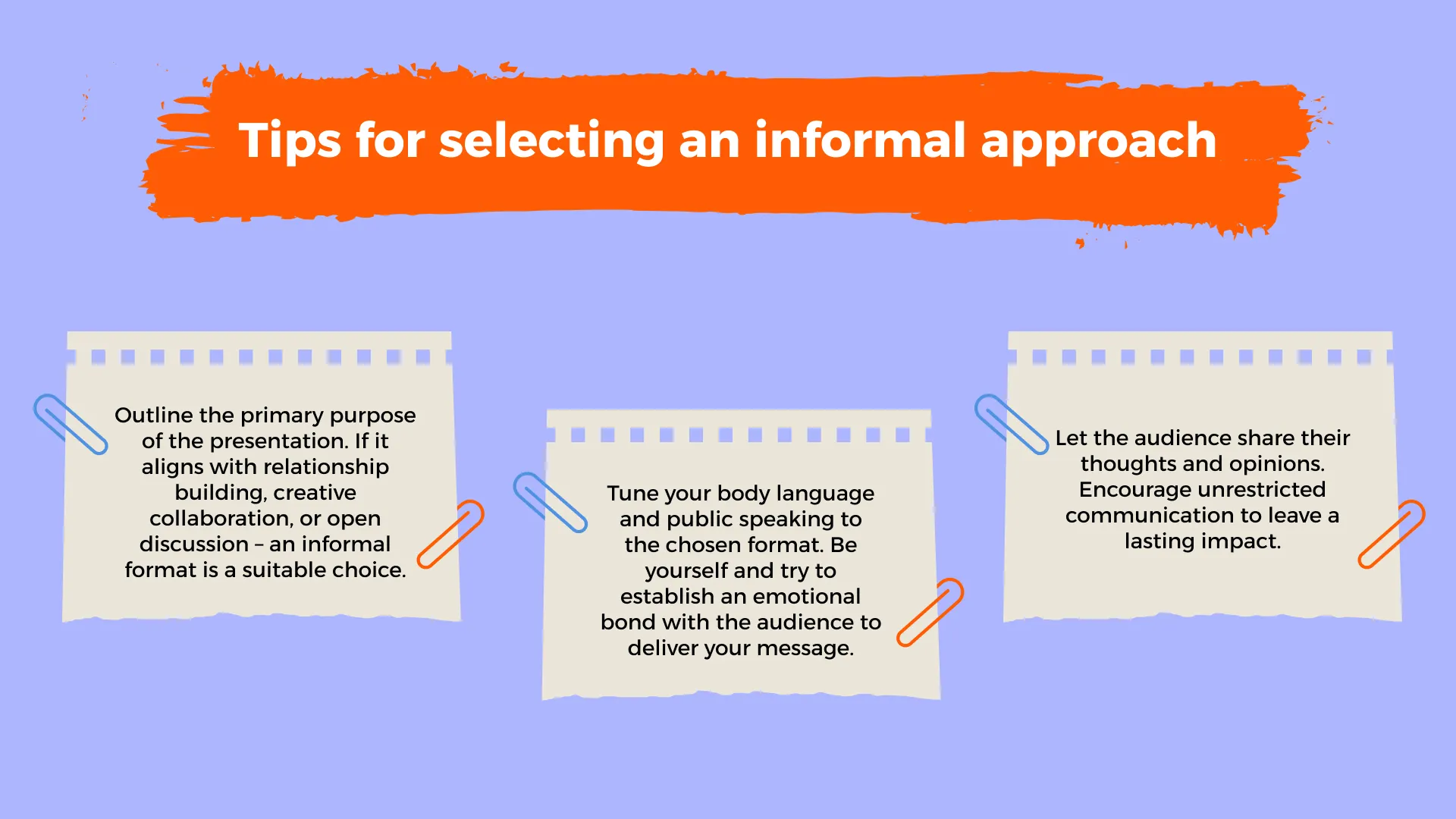
- Outline the primary purpose of the presentation. If it aligns with relationship building, creative collaboration, or open discussion – an informal format is a suitable choice.
- Tune your body language and public speaking to the chosen format. Be yourself and try to establish an emotional bond with the audience to deliver your message.
- Let the audience share their thoughts and opinions. Encourage unrestricted communication to leave a lasting impact.
Key Differences Between Informal and Formal PresentationsTo help you distinguish between these different forms of presentation, Whitepage experts created a simple yet memorable comparison table.
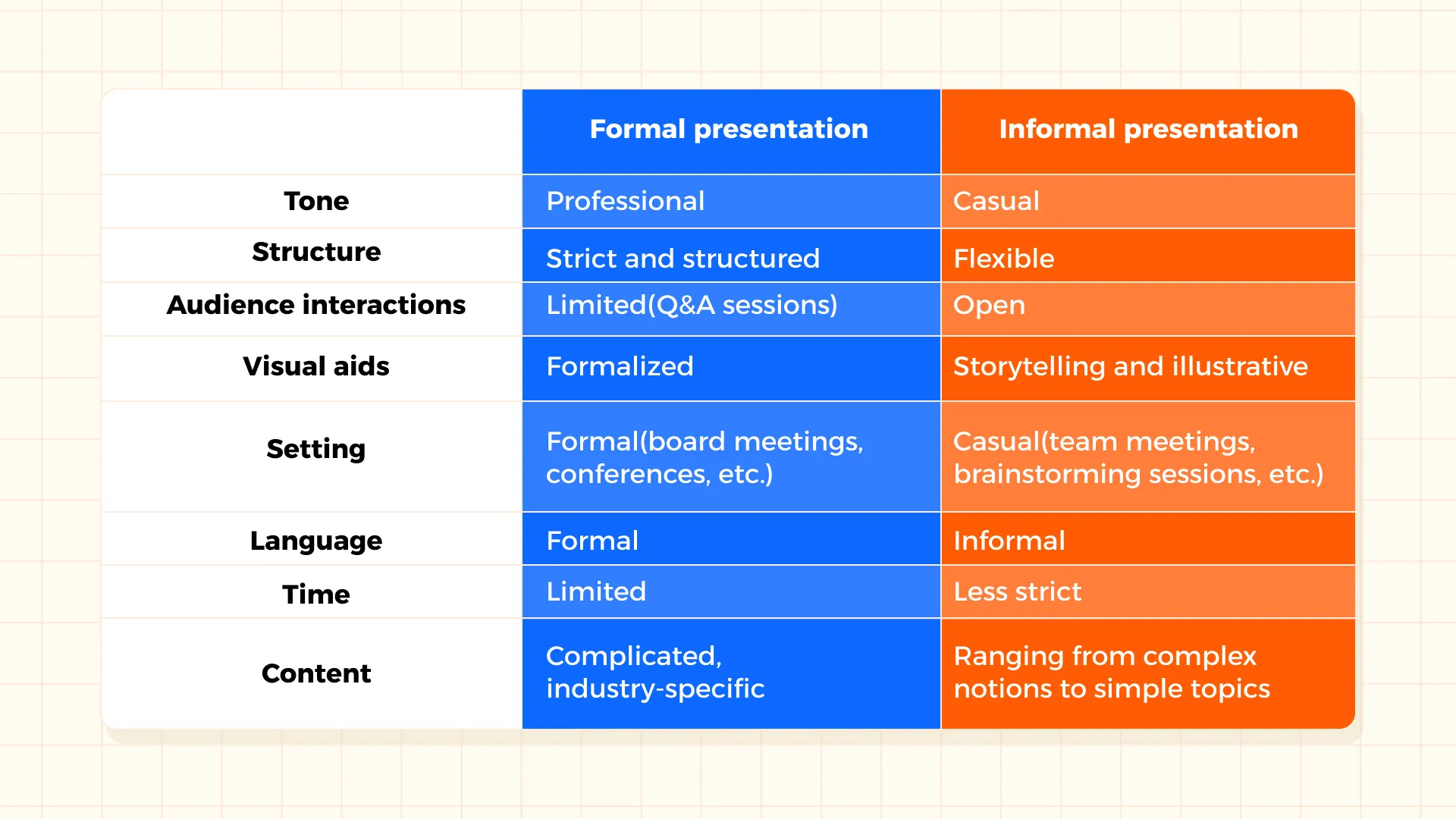
Tailoring Your Presentation to Your Audience
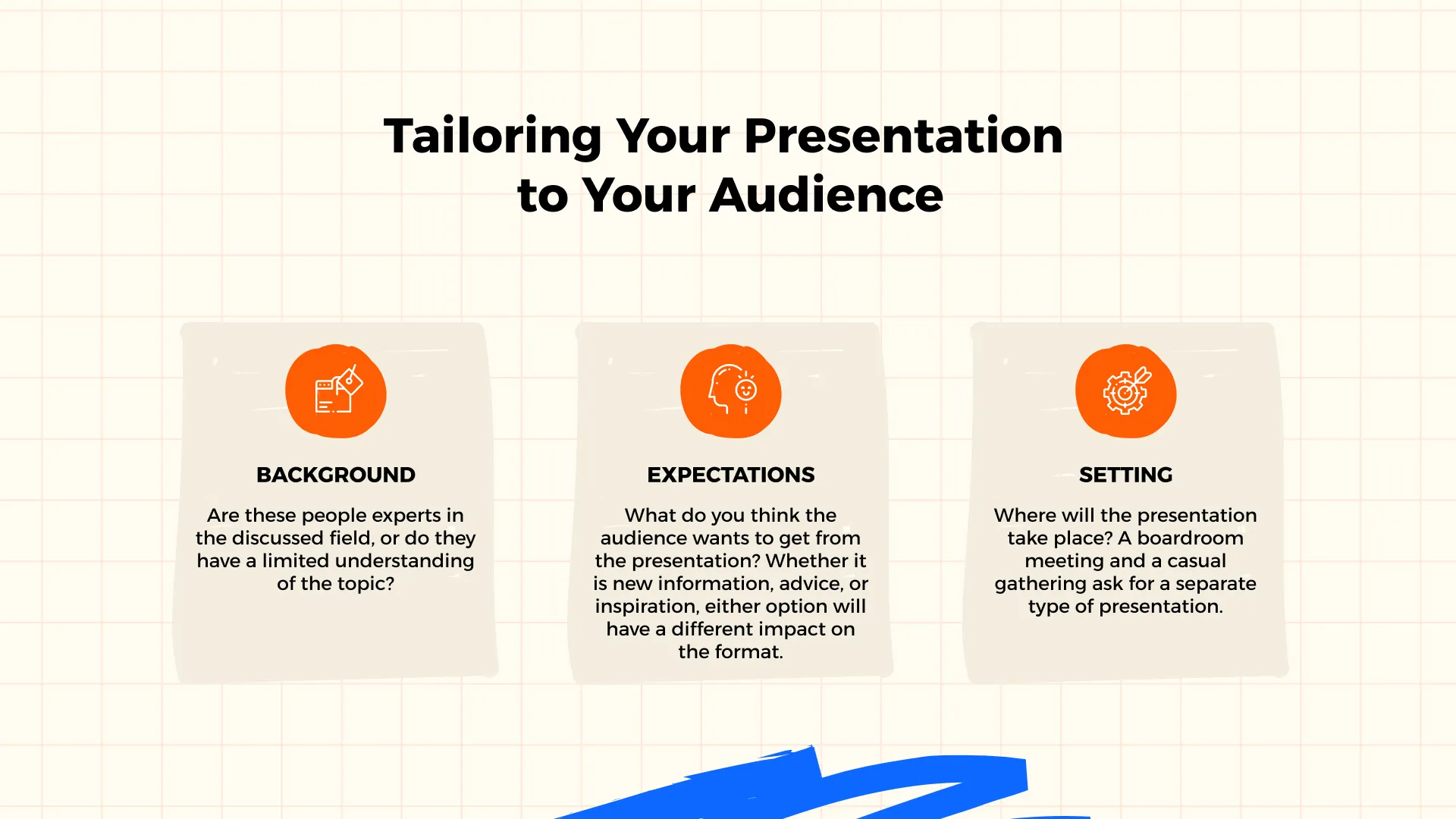
Your audience is the best definition of the presentation you need. You must choose the format that resonates with the audience to succeed. Different people prefer different kinds of presentations. Not to point blindly into one of the existing directions, you should start with an in-depth analysis of those you are going to present for. Pay attention to these factors:
- Background. Are these people experts in the discussed field, or do they have a limited understanding of the topic?
- Expectations. What do you think the audience wants to get from the presentation? Whether it is new information, advice, or inspiration, either option will have a different impact on the format.
- Setting. Where will the presentation take place? A boardroom meeting and a casual gathering ask for a separate type of presentation.
In case you feel that the gathered information is slightly insufficient, you can also consider the environment. For instance:
- Creative workshop. The audience seeking ways to communicate in a relaxed and creative atmosphere will undoubtedly appreciate an informal presentation example.
- Academic conference. A room filled with scholars and researchers will thirst for a formal presentation spiced with new information, complicated concepts, and unwavering authority.
- Sales pitch. Preaching to potential clients enquires for a well-balanced mixture of both. A professional presentation with a fair share of storytelling, persuasion, and personal experience would suffice.
Lastly, you shouldn’t forget about the accessibility of your presentation. No matter if it is a formal or informal format, depending on the specific needs of the audience, you may need to create a color blindness presentation or provide handouts for a presentation to suffice them.
Tips for Creating Effective Formal and Informal Presentations
The task how to create a slide deck with a formal or informal incline may be more challenging than it initially seems. However, nothing is impossible if you have time-tested, actionable tips from devout professionals at hand!
Tips for formal presentations
- Use clear, professional, and concise language. Steer clear of slang, jargon, and overly specific terms.
- Stick to a logical presentation structure.
- Use relevant images, charts, and graphs to make complicated details more comprehensible.
- Make the presentation accessible. Use high-quality visual aids and readable font size for presentation.
- Use available engagement techniques, such as Q&A sessions, to make the audience more involved. Explain complex notions through real-life examples.
- Keep the presentation pace steady and confident. Learn how to talk more eloquently to assist the audience in digesting complicated ideas.
- Practice presentation delivery before you head for the real-life event. You can ask your friends and colleagues to watch you present and provide critical feedback. Don’t be afraid to rehearse more than once until you find the best pace and eliminate potential weak spots.
Tips for informal presentations
- Work on the tone of delivery. Make sure it is friendly and conversational enough to connect with the audience. Don’t shy away from personal stories and anecdotes. Use humor to lighten up the atmosphere and make the presentation more engaging and impactful.
- Remain flexible. This will tell you how to make your presentation longer or shorter depending on the circumstances so that the audience does not see it. Don’t be afraid to improvise if the setting allows it. Monitor your audience’s response closely to tune in with their mood.
- Visual aid. Use relevant visuals to support and intensify the overall impact of the presentation.
- Audience interaction. Encourage the viewers to take part in the presentation. They can ask questions, suggest alternative ideas, provide feedback, and so on, as long as it keeps the audience interested.
- Personal touch. Support the main topic of the presentation through your demeanor. Be open, genuine, and authentic. Don’t repress your personality. Let it shine.
- Rehearsals. Despite the impromptu nature of informal presentations, you should practice delivery to ensure that your message will be easy to grasp. Besides, friendly feedback from colleagues can help you establish a more relaxed and inviting behavior.
Leveraging Technology in Presentations
Present-day technology can be both a blessing and a curse. Today, we’ll focus on the former. Well-chosen tools and software can become an irreplaceable component of a successful presentation, no matter if it is a formal or informal format that you are working on.
Practical tools for formal presentations
- PowerPoint – the software has been designed to create well-structured and organized presentations, which makes the tool irreplaceable when it comes to formal presentations. There are multiple handy features for content organization and visual aids. Available graphs, charts, and tables ensure that the discussed information is more understandable and easy to digest.
- Keynote –is yet another popular presentation software spiced with multiple handy presentation templates, animations, graphics, and more. The tool will help you create an appealing and informative formal presentation that boosts interest and leaves a desired impact.
Creative tools for informal presentations:
- Prezi – an interactive software for creative and engaging presentations. Prezi enlists such unique and valuable features as customizable templates, animations, collaboration tools, and interactive elements to encourage creativity.
- Boardmix – an interactive whiteboard fit for brainstorming, collaborative interactions, and strategy sessions. Besides, it allows the presenter to interact with the content in real time, making the presentation twice as flexible.
Surely, technology can help you enhance the presentation, but you must know how to use it correctly. Whitepage experts will share a few practical pieces of advice on how to integrate technology into your presentation:
- Know your arsenal: you must be fully aware of which of the following is appropriate for a formal presentation and which should be reserved for an informal format.
- Make it relevant: don’t use technological aid for the mere sake of it. Make sure it introduces a critical layer that supports the main message.
- Test it: whether it is a new tool or the one you’ve been working with for ages, you should practice using it before the presentation.
- Use backup: things happen, and technology fails or backfires. That is why you should always have a plan B to switch to.
Conclusion
Sometimes, a presentation is your best bet for succeeding with the desired goal. That is why it is so critical to pick the style that will help you achieve it. Both formal and informal presentations have definitive features aimed at the specific audience type. If you choose the proper format, you will not only deliver the main message but make it resonate with the audience and drive them toward positive conclusions.
Talk to a presentation design expert now!
Let's Talk
FAQ

Read more




.avif)
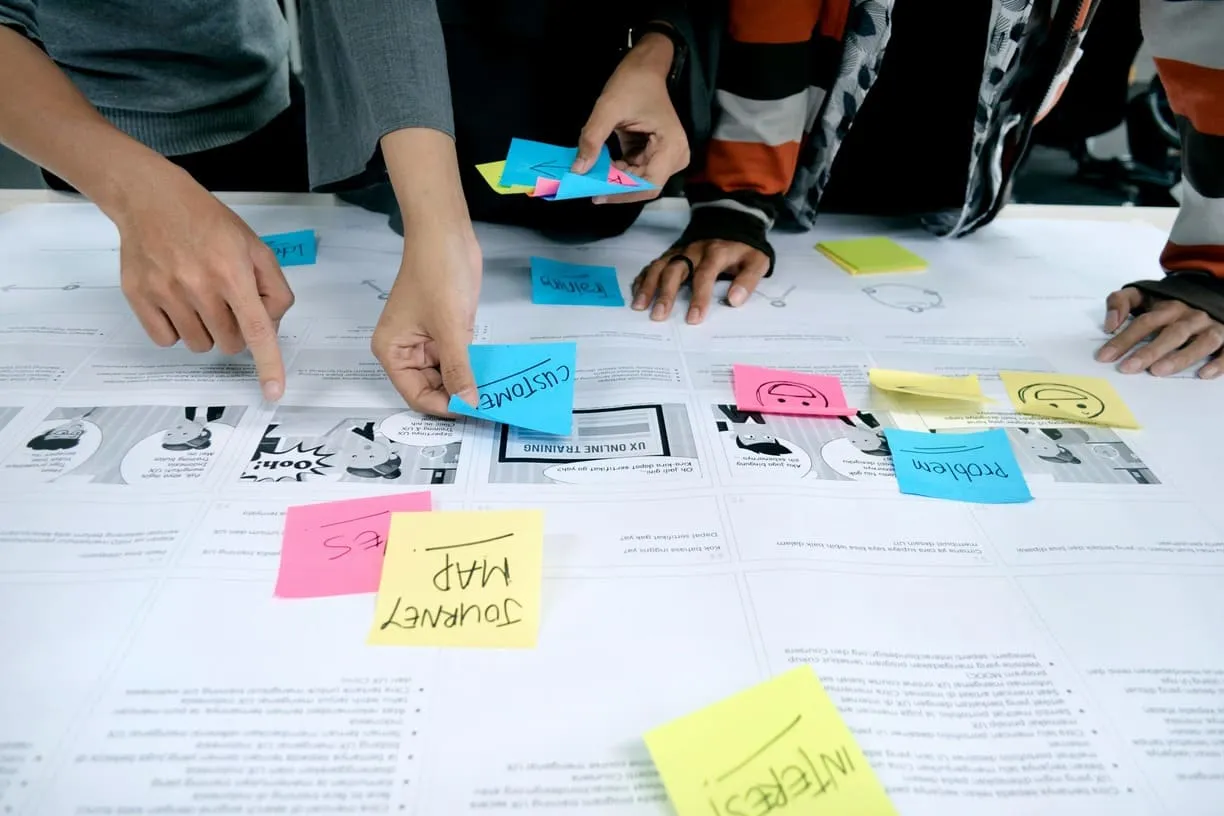
.webp)
.webp)

















